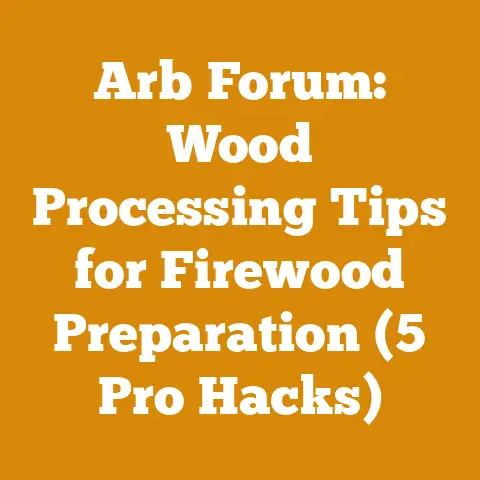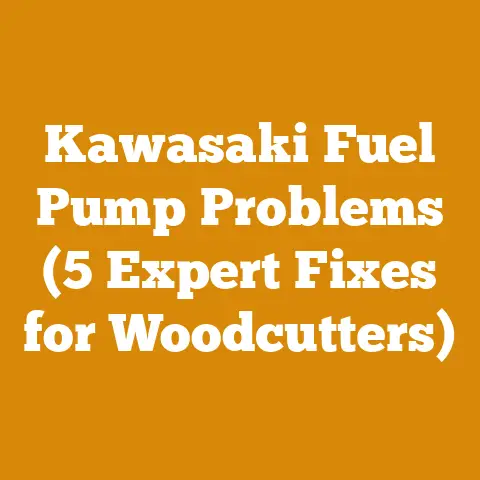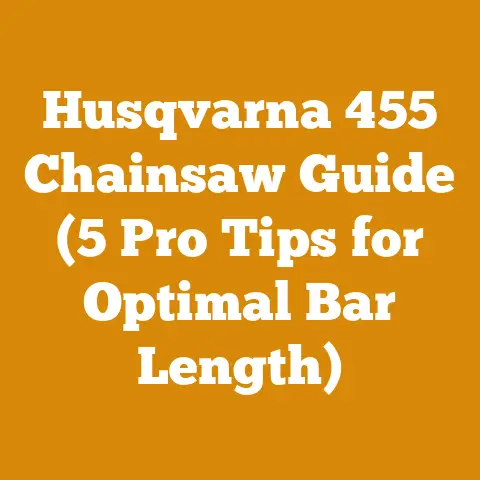How Much Stump Grinding Cost (5 Pro Tips for Accurate Pricing)
Sustainability isn’t just a buzzword; it’s the bedrock of responsible wood processing and firewood preparation. We’re not just talking about chopping down trees; we’re talking about managing a precious resource for generations to come. It’s about balancing our needs today with the needs of tomorrow. This extends even to seemingly small tasks like stump grinding. After all, responsible land management is part of the bigger picture.
And that’s where the question of stump grinding comes into play. You’ve got a stubborn stump marring your landscape, and the thought of it lingering there forever isn’t exactly appealing. But before you reach for the phone and call the first stump grinding service you find, a crucial question arises: “How much will this actually cost?”
That’s exactly what we are going to explore. We’ll delve into the factors that influence the price of stump grinding, equipping you with the knowledge to get accurate estimates, avoid hidden fees, and ultimately, make an informed decision. I’ll share my insights, drawn from years of experience working with landowners, arborists, and fellow wood-processing enthusiasts. Think of this as your insider’s guide to navigating the often-murky waters of stump grinding costs.
How Much Does Stump Grinding Cost? (7 Pro Tips for Accurate Pricing)
Stump grinding might seem like a simple task – a machine obliterating a leftover tree base. However, the cost can vary widely, and understanding the influencing factors is key to avoiding overspending. I’ve seen homeowners get sticker shock, thinking they were getting a good deal only to be hit with unexpected charges. My goal is to arm you with the knowledge to prevent that.
1. Stump Size: The Obvious Culprit (and How to Measure It Right)
The most significant factor influencing the cost of stump grinding is, unsurprisingly, the stump’s size. Larger stumps require more time, effort, and machine power to remove. Stump grinding services typically price their work based on one of three things:
- Per-inch diameter: This is the most common pricing method. You’ll be charged a certain amount for each inch of the stump’s diameter. For example, a price of $3-$8 per inch is fairly standard.
- Per-stump: This method is often used for smaller jobs involving multiple similarly sized stumps. The price is a fixed amount for each stump, regardless of its exact size (within a reasonable range).
- Hourly rate: This is less common but may be used for very large or complex jobs. Hourly rates typically range from $100-$200 per hour, depending on the equipment and experience of the operator.
Pro Tip: Accurate measurement is crucial. Don’t just eyeball it! Measure the stump’s diameter at its widest point, at ground level. If the stump is irregularly shaped, take multiple measurements and average them. Providing accurate measurements upfront will help you get a more precise quote and avoid surprises later.
My Experience: I once had a client who underestimated the size of a massive oak stump in their backyard. They initially told the stump grinding service it was 24 inches in diameter. When the crew arrived, they discovered it was closer to 40 inches! The price increased significantly, leading to a tense negotiation. Save yourself the headache and measure carefully.
2. Stump Location and Accessibility: A Hidden Cost Driver
Where the stump is located can dramatically impact the cost. Stumps that are easily accessible to the stump grinding machine will be cheaper to remove than those in hard-to-reach locations. Consider these factors:
- Terrain: Is the stump on flat, level ground, or is it on a slope or in a ditch? Steep slopes or uneven terrain can make it difficult to maneuver the machine, increasing the time and effort required.
- Obstacles: Are there fences, trees, shrubs, or other obstacles surrounding the stump? These can restrict access and require the operator to take extra precautions, slowing down the process.
- Underground utilities: The presence of underground utilities (gas lines, water pipes, electrical cables) can significantly increase the cost. The stump grinding service may need to call a utility locating service to mark the location of these utilities before starting work. This adds time and can also limit the depth to which the stump can be ground.
- Gate/Access Width: Can the stump grinder fit through your gate? Some large machines need a wide path. If the stump grinder can’t easily access the area, they may need to use a smaller machine or even do some manual work, driving up the price.
Actionable Tip: Before getting a quote, clear away any brush, debris, or obstacles around the stump. This will make it easier for the stump grinding service to assess the job and provide a more accurate estimate. Take photos of the stump and its surroundings and send them to the service beforehand. This can help them identify potential challenges and provide a more informed quote.
My Experience: I remember a job where the stump was located in a backyard accessible only through a narrow gate. The stump grinding service had to use a smaller, less powerful machine, which took significantly longer and increased the overall cost. Had the homeowner known this beforehand, they might have considered removing a section of the fence to allow access for a larger machine.
3. Stump Condition and Type of Wood: Not All Stumps Are Created Equal
The condition and type of wood of the stump can also affect the cost.
- Rotten Stumps: You might think a rotten stump would be easier to grind, but this isn’t always the case. Rotten wood can be soft and mushy, making it difficult for the grinder to get a good grip. It can also create a lot of dust and debris, which can slow down the process.
- Hardwood vs. Softwood: Hardwood stumps (oak, maple, etc.) are generally more difficult to grind than softwood stumps (pine, fir, etc.). Hardwoods are denser and more resistant to abrasion, requiring more time and machine power to remove.
- Presence of Rocks or Debris: If the stump is embedded with rocks, concrete, or other debris, the grinding process will be much more difficult and time-consuming. The operator may need to stop frequently to remove these obstacles, and the grinder blades may wear out more quickly.
Data Point: Grinding a hardwood stump can take up to twice as long as grinding a softwood stump of the same size. This difference in time translates directly into increased labor costs.
Strategic Insight: When describing the stump to the grinding service, be as detailed as possible about its condition and any potential obstacles. This will help them anticipate challenges and provide a more accurate quote.
4. Depth of Grinding: How Deep Do You Want to Go?
The depth to which you want the stump ground can also influence the cost. Grinding the stump just below the surface may be sufficient if you simply want to remove the visible portion. However, if you plan to replant grass or other vegetation in the area, you’ll need to grind the stump deeper to allow for proper root growth.
- Standard Depth: Most stump grinding services offer a standard grinding depth of 4-6 inches below the surface.
- Deeper Grinding: Grinding to a depth of 12 inches or more is often necessary for replanting or construction projects. This will, of course, increase the cost.
- Root Removal: Removing the entire root system is rarely necessary and can be very expensive. In most cases, grinding the stump and the main lateral roots is sufficient.
Actionable Tip: Consider your long-term plans for the area where the stump is located. If you plan to replant, be sure to specify the desired grinding depth when getting a quote.
My Experience: I had a client who initially opted for a shallow grinding depth to save money. However, they later decided to build a patio in the area and had to hire the stump grinding service to come back and grind the stump deeper. This ended up costing them more in the long run.
5. Disposal of Grindings: Who’s Cleaning Up This Mess?
The cost of stump grinding typically includes the grinding process itself, but it may not include the disposal of the grindings (the wood chips and debris produced during the grinding process).
- On-Site Disposal: Some services will simply leave the grindings on-site, allowing you to use them as mulch or compost. This is the least expensive option.
- Spreading Grindings: Some services will spread the grindings around the area, leveling them out and blending them into the surrounding soil. This is a good option if you want to improve the soil quality in the area.
- Hauling Away: The most expensive option is to have the service haul away the grindings. This is often necessary if you don’t want the grindings on your property or if you have a large volume of grindings.
Strategic Insight: Before getting a quote, ask the stump grinding service what their disposal options are and what the associated costs are. Consider your own needs and preferences when making your decision.
My Experience: I always encourage clients to consider using the grindings as mulch. They’re a valuable resource that can help improve soil health and reduce weed growth. Plus, it saves you the cost of disposal!
6. Company Reputation and Insurance: Don’t Cut Corners on Quality
While price is important, it shouldn’t be the only factor you consider when choosing a stump grinding service. A reputable company with experienced operators and proper insurance is worth the extra cost.
- Insurance: Make sure the company has liability insurance to protect you in case of accidents or damage to your property.
- Experience: Choose a company with experienced operators who know how to safely and efficiently operate the stump grinding machine.
- Reviews and References: Check online reviews and ask for references from previous customers. This will give you a good idea of the company’s reputation and quality of work.
Data Point: According to the Tree Care Industry Association (TCIA), hiring an uninsured tree care company can leave you liable for any injuries or property damage that occur on your property.
Actionable Tip: Don’t be afraid to ask the stump grinding service for proof of insurance and references. A reputable company will be happy to provide this information.
My Experience: I once witnessed a homeowner hire an uninsured stump grinding service to save a few bucks. The operator accidentally damaged the homeowner’s sprinkler system, and the homeowner was left to pay for the repairs out of pocket. It ended up costing them more than if they had hired a reputable, insured company in the first place.
7. Getting Multiple Quotes: Your Best Weapon Against Overpaying
The best way to ensure you’re getting a fair price for stump grinding is to get multiple quotes from different companies. This will give you a good idea of the average cost in your area and allow you to compare prices and services.
- Contact at least three different companies: The more quotes you get, the better.
- Provide accurate information: Be sure to provide each company with the same information about the stump (size, location, condition, desired grinding depth, etc.).
- Ask about all potential fees: Make sure the quote includes all potential fees, such as travel fees, disposal fees, and utility locating fees.
- Compare apples to apples: When comparing quotes, make sure you’re comparing the same services. Some companies may offer additional services, such as root removal or soil restoration, that are not included in the base price.
Strategic Insight: Don’t automatically choose the cheapest quote. Consider the company’s reputation, experience, and insurance coverage when making your decision.
My Experience: I always advise clients to get at least three quotes. I’ve seen prices vary by as much as 50% between different companies for the same job. Getting multiple quotes is the best way to ensure you’re getting a fair price.
Unique Insight: Consider bundling stump grinding with other tree care services, such as tree trimming or removal. Many companies offer discounts for bundled services. It’s a “kill two birds with one stone” scenario that can save you money.
Case Study: Optimizing Cost and Efficiency in Stump Grinding
Let’s look at a real-world example. A local community center had three large oak stumps remaining after a tree removal project. They contacted three different stump grinding services for quotes.
- Company A: Quoted $5 per inch of diameter, with a disposal fee of $50 per stump. Total estimated cost: $750 (including disposal).
- Company B: Quoted $6 per inch of diameter, with no disposal fee. Total estimated cost: $900.
- Company C: Quoted $4 per inch of diameter, but required the community center to handle the disposal of the grindings. Total estimated cost: $600 (excluding disposal).
The community center initially leaned towards Company C because of the lower price. However, they soon realized that the cost of renting a truck and disposing of the grindings themselves would likely exceed the $150 difference between Company C and Company A.
Ultimately, they chose Company A. They negotiated with Company A to spread the grindings on-site instead of hauling them away, saving them $150 and improving the soil quality in their garden area. They also verified Company A’s insurance and checked online reviews, ensuring they were hiring a reputable company.
This case study highlights the importance of getting multiple quotes, considering all potential fees, and negotiating with the service provider.
Workflow Optimization in Stump Grinding
Beyond just the cost, let’s delve into optimizing the process of stump grinding. Efficiency isn’t just about speed; it’s about doing the job right the first time, minimizing disruption, and maximizing value.
Preparing the Site for Efficient Stump Grinding
The better prepared the site, the faster and more efficient the stump grinding process will be. This translates directly into cost savings, especially if you’re paying an hourly rate.
- Clear Obstacles: Remove any rocks, debris, or vegetation around the stump. This will prevent damage to the grinder blades and allow the operator to work more efficiently.
- Mark Underground Utilities: Contact your local utility companies to mark the location of any underground utilities. This is crucial for safety and will prevent costly damage.
- Provide Access: Ensure that the stump grinding machine has easy access to the stump. Trim any branches or shrubs that may be obstructing the path.
- Water the Stump: If the stump is dry and hard, watering it a few days before the grinding process can help soften the wood and make it easier to grind.
My Experience: I’ve seen homeowners try to save time by skipping the site preparation step. This almost always backfires. The operator ends up spending more time clearing obstacles and dealing with unexpected problems, which increases the overall cost.
Optimizing the Grinding Process
Even with a well-prepared site, there are still ways to optimize the grinding process itself.
- Communicate with the Operator: Clearly communicate your desired grinding depth and disposal preferences to the operator before they begin work.
- Monitor the Progress: Keep an eye on the grinding process to ensure that the operator is meeting your expectations.
- Provide Feedback: Don’t hesitate to provide feedback to the operator if you have any concerns or suggestions.
- Consider a Two-Pass Approach: For very large stumps, consider a two-pass approach. The operator can make a shallow pass to remove the bulk of the stump, then make a deeper pass to achieve the desired grinding depth.
Actionable Tip: If you’re concerned about the noise level of the stump grinding machine, consider informing your neighbors in advance. This can help prevent complaints and maintain good relations.
After the Grinding: Maximizing the Value of the Grindings
As we discussed earlier, the grindings produced during the stump grinding process are a valuable resource that can be used as mulch or compost. Here are some tips for maximizing their value:
- Use as Mulch: Spread the grindings around trees, shrubs, or flower beds to help retain moisture, suppress weeds, and improve soil health.
- Mix with Compost: Add the grindings to your compost pile to help improve its texture and aeration.
- Use as a Soil Amendment: Mix the grindings with soil to improve its drainage and fertility.
- Consider Wood Chip Gardening: Wood chip gardening is a no-dig gardening method that uses wood chips as the primary growing medium.
Data Point: Wood chip mulch can reduce weed growth by up to 80% and can help retain soil moisture by up to 50%.
My Experience: I’ve seen homeowners transform barren landscapes into thriving gardens simply by using wood chip mulch. It’s a sustainable and cost-effective way to improve soil health and beautify your property.
Sustainable Stump Grinding Practices
Sustainability isn’t just about using the grindings as mulch; it’s about making responsible choices throughout the entire stump grinding process.
Choosing Environmentally Friendly Equipment
Some stump grinding machines are more environmentally friendly than others. Look for machines that:
- Use low-emission engines: These engines produce fewer pollutants and greenhouse gases.
- Are fuel-efficient: Fuel-efficient machines consume less fuel, reducing your carbon footprint.
- Use biodegradable lubricants: Biodegradable lubricants are less harmful to the environment if they leak or spill.
Minimizing Soil Disturbance
Stump grinding can disturb the soil around the stump, potentially damaging plant roots and causing erosion. Here are some tips for minimizing soil disturbance:
- Use a smaller machine: A smaller machine will cause less soil disturbance.
- Avoid grinding in wet conditions: Grinding in wet conditions can compact the soil and make it more susceptible to erosion.
- Replant the area: After grinding, replant the area with native plants to help stabilize the soil and prevent erosion.
Supporting Sustainable Forestry Practices
The trees that are removed to create the stumps in the first place should be harvested from sustainably managed forests. Look for companies that:
- Are certified by the Forest Stewardship Council (FSC): FSC certification ensures that the trees are harvested from forests that are managed in a sustainable and responsible manner.
- Practice selective harvesting: Selective harvesting involves removing only certain trees from a forest, leaving the remaining trees to grow and regenerate.
- Replant trees after harvesting: Replanting trees after harvesting helps to ensure the long-term health and sustainability of the forest.
Actionable Tip: When hiring a stump grinding service, ask them about their sustainability practices. Choose a company that is committed to protecting the environment.
Stump Grinding Safety
Safety is paramount in any wood processing or stump removal activity. Stump grinding is no exception. The machinery involved is powerful and can be dangerous if not handled correctly.
- Personal Protective Equipment (PPE): Always wear appropriate PPE, including safety glasses, hearing protection, work gloves, and sturdy footwear.
- Machine Inspection: Inspect the stump grinder before each use to ensure that it is in good working order. Check the blades for sharpness and damage, and make sure all safety guards are in place.
- Clear the Area: Before starting the stump grinding process, clear the area of any bystanders, pets, or obstacles.
- Maintain a Safe Distance: Keep a safe distance from the stump grinder while it is in operation.
- Never Operate Under the Influence: Never operate a stump grinder if you are under the influence of alcohol or drugs.
- Know Your Limits: If you are not comfortable operating a stump grinder, hire a professional.
My Experience: I’ve seen firsthand the devastating consequences of neglecting safety precautions when operating a stump grinder. It’s not worth the risk. Always prioritize safety.
Legal and Regulatory Considerations: Depending on your location, there may be local regulations or permits required for stump grinding activities. Check with your local authorities to ensure that you are in compliance with all applicable laws and regulations. This is especially important if you are grinding stumps near property lines or in environmentally sensitive areas.
Conclusion: Empowering You to Make Informed Decisions
Stump grinding costs can vary significantly depending on a number of factors, including the size, location, and condition of the stump, the desired grinding depth, and the disposal options. By understanding these factors and following the tips outlined in this article, you can get accurate quotes, avoid hidden fees, and ultimately, make an informed decision about whether or not to hire a stump grinding service.
Remember, sustainability is key. Consider using the grindings as mulch or compost, choosing environmentally friendly equipment, and supporting sustainable forestry practices.
Key Takeaways:
- Measure accurately: Accurate measurements are essential for getting accurate quotes.
- Consider accessibility: Stumps in hard-to-reach locations will be more expensive to remove.
- Get multiple quotes: Getting multiple quotes is the best way to ensure you’re getting a fair price.
- Factor in disposal costs: Disposal costs can significantly impact the overall cost of the job.
- Prioritize safety: Always prioritize safety when operating a stump grinder.
Next Steps:
- Assess the stumps you need to remove, noting their size, location, and condition.
- Contact at least three different stump grinding services in your area for quotes.
- Compare the quotes carefully, considering all potential fees and services.
- Choose a reputable company with experienced operators and proper insurance.
- Prepare the site for efficient stump grinding.
- Monitor the grinding process and provide feedback to the operator.
- Use the grindings as mulch or compost.
By following these steps, you can ensure that your stump grinding project is completed safely, efficiently, and cost-effectively. And remember, responsible land management, even down to the removal of a stump, contributes to a more sustainable future.






